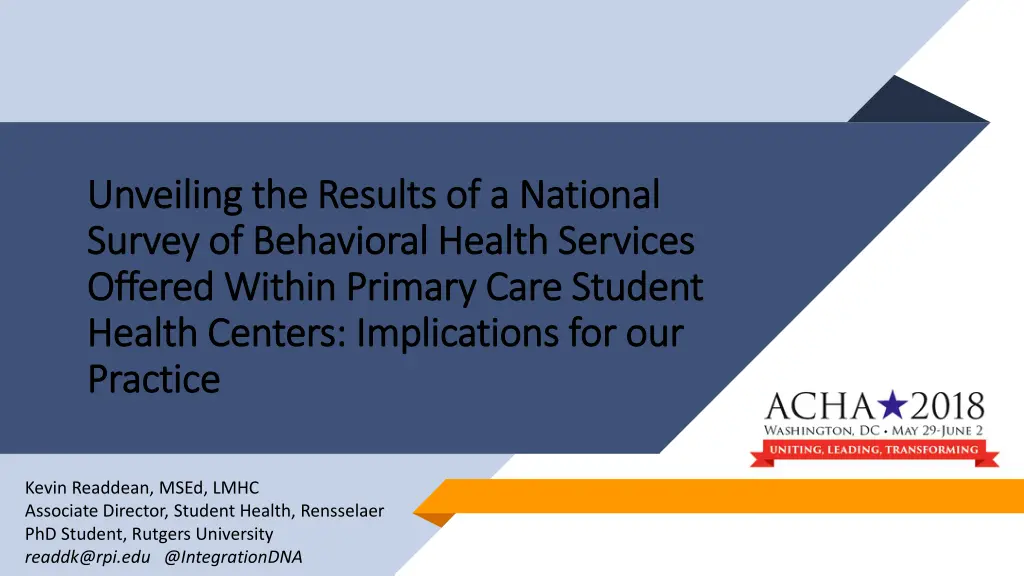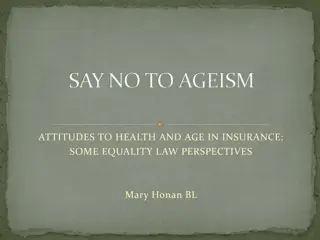
Behavioral Health Services Integration in Primary Care Student Health Centers
Explore the findings of a national survey on the integration of behavioral health services within primary care student health centers. Understand the organizational models, emerging roles, and implications for practice in delivering comprehensive care. Learn about the Primary Care Behavioral Health Survey Project objectives and the importance of integrating mental health and physical health care for optimal outcomes.
Download Presentation

Please find below an Image/Link to download the presentation.
The content on the website is provided AS IS for your information and personal use only. It may not be sold, licensed, or shared on other websites without obtaining consent from the author. If you encounter any issues during the download, it is possible that the publisher has removed the file from their server.
You are allowed to download the files provided on this website for personal or commercial use, subject to the condition that they are used lawfully. All files are the property of their respective owners.
The content on the website is provided AS IS for your information and personal use only. It may not be sold, licensed, or shared on other websites without obtaining consent from the author.
E N D
Presentation Transcript
Unveiling the Results of a National Unveiling the Results of a National Survey of Behavioral Health Services Survey of Behavioral Health Services Offered Within Primary Care Student Offered Within Primary Care Student Health Centers: Implications for our Health Centers: Implications for our Practice Practice Kevin Readdean, MSEd, LMHC Associate Director, Student Health, Rensselaer PhD Student, Rutgers University readdk@rpi.edu @IntegrationDNA
Learning Objectives Participants will be able to: identify the variety of organizational models and evidenced-based practices that surround the delivery of primary care behavioral health services in college health describe the emerging titles and roles of behavioral health staff added to the primary care team discuss the implications of the findings as they relate to their organizations and the existing literature on primary care behavioral health integration. @IntegrationDNA
Conflicts of Interest I have no actual or potential conflict of interest in relation to this educational activity or presentation. However potential bias SUNY at Cobleskill: 13 years in integrated heath/counseling service Rensselaer: 10 years in integrated health/counseling service ACHA White paper: Considerations for integration of counseling and health services on college and university campuses Rutgers University: PhD student, Health Sciences studying the fundamental, distinctive characteristics of the practice of integrated primary care behavioral health Married, Cohabitating, or Dating? https://www.polleverywhere.com/multiple_choice_polls/RfBYp8u4GkDzSAu @IntegrationDNA
IntegrationDNA The interconnected double-helix of physical and mental health care with the sequence of the four bases (ATCG) shaping the design of the organization. Administration procedural and financial integration Technology EHR integration Clinical treatment coordination and integration Geographic how space is shared to support collaboration and reflect integration @IntegrationDNA
Primary Care Behavioral Health Survey Project Objectives Benchmark current organizational structures of primary care student health centers. Measure the degree of integration of behavioral health practices within primary care student health centers using the Practice Integration Profile (PIP) survey. Test the following hypotheses about the relationships between organizational characteristics and levels of integration: 1. Integrated centers will have higher PIP scores than non-integrated centers. 2. Integrated centers with longer history of integration will have higher PIP scores than integrated centers with shorter history of integration. 3. Non-integrated centers with plans to integrate will have higher PIP scores than non- integrated centers without plans to integrate. 4. Centers with higher numbers of Behavioral Health (BH) FTE staff will have higher PIP scores than centers with lower numbers of BH FTE staff. @IntegrationDNA
Thank You! ACHA, Section Leaders, Rutgers Advisors, Respondents Pilot survey Emeriti Directors: n=13 Final survey: 716 ACHA RMI s invited, 189 responses (26% response rate), good representation of the population of ACHA institutions 54 items: demographics, organizational structures, and the Practice Integration Profile (PIP) @IntegrationDNA
Demographics @IntegrationDNA
Demographics @IntegrationDNA
Demographics @IntegrationDNA
Demographics @IntegrationDNA
Organizational Models - Integrated 18% 4% 10% 9% 1% Integrated Contracted Health & Counseling @IntegrationDNA
Organizational Models: Non-Integrated 45% 11% 2% @IntegrationDNA
Survey Data Comparison Organizational Model Integration 2007 Survey 2018 Survey 45% 11% 2% 18% 9% 4% 10% 1% Health director and counseling director report to a single senior administrator Health director and counseling director report to different senior administrators Contracted/Outsourced - Primary Care Only Center Director with Director of Health and Director of Counseling Single chief health and counseling director reports to a senior administrator Health director reports to the counseling director who reports to a senior administrator Counseling director reports to the health director who reports to a senior administrator Contracted/Outsourced - Primary Care and Counseling Services. 58% Not Integrated 74% 8% 6% 4% 8% - 42% Integrated 26% @IntegrationDNA
Survey Data Comparison Non-Integrated vs Integrated Organizational Models 2007 to 2018 80% 74% 70% 60% 58% 50% 40% 42% 30% 20% 26% 10% 0% 2007 Survey 2018 Survey @IntegrationDNA Not Integrated Integrated
More Survey data on Integration 45% 40% 35% 42% 30% 25% 28% 20% 25% 26% 25% 15% 10% 5% 0% 2007** 2011* 2013* 2015* 2018*** *National Survey of Counseling Center Directors **ACHA Mental Health Best Practices Taskforce ***Primary Care Behavioral Health Survey @IntegrationDNA
Factors Driving Integration 2007 Top three factors that drove the integration: Improve continuity of care Philosophy of care Upper administrative directive 2018 Factors driving the planned integration: Improve continuity of care Philosophy of care Physical facilities @IntegrationDNA
Small Group Discussion Regardless of your organizational model: In what ways are your primary care and behavioral health services integrated? @IntegrationDNA
Practice Integration Profile Kessler and colleagues Used with permission Demonstrated face, content and internal validity Operationalizes key elements of the Agency for Healthcare Research and Quality (AHRQ) Lexicon for Behavioral Health and Primary Care Integration Quantifies levels of integration 6 dimensions and overall PIP score @IntegrationDNA
Practice Integration Profile 30 items; 6 dimensions (subscales) 1. Practice Workflow (protocols, registries, coordination of care) 2. Clinical Services and Providers (BH clinicians and BH interventions) 3. Workspace Arrangement (co-location and shared records) 4. Integration Method (collaboration on treatment plans) 5. Identification of Need (screening methods) Patient Engagement and Retention (systematic follow-up for BH) Scoring: 5-point Likert scale (0-25-50-75-100) 6. @IntegrationDNA
PIP Scores Total PIP Score Overall Scores Mean (SD) Range Institution Type ( sd) Public 4 Year Private 4 Year Public and Private 2 Year Student Enrollment ( sd) Under 2,000 2,000 to 4,999 5,000 to 9,999 10,00 to 19,999 20,000 or more (N = 169) 44.8 (18.8) 1.7 - 84.5 (N = 169) 46.2 (20.0) 43.7 (16.6) 35.6 (23.6) (N = 169) 38.0 (17.0) 44.4 (17.3) 42.3 (20.2) 44.9 (18.6) 48.7 (20.4) @IntegrationDNA
Hypothesis 1 Integrated centers will have higher PIP scores than non-integrated centers. Clinical Services and Providers (N = 168) 55.3 (26.0) 59.2 (21.0) Patient Engagement and Retention (N = 164) 45.8 (21.2) 50.9 (18.7) Practice Workflow Identification of Need (N = 165) 40.7 (25.6) 40.3 (24.7) Total PIP Score Organizational Model ( sd) Not Integrated Integrated (N = 169) 42.1 (20.0) 47.6 (17.1) (N = 167) 45.1 (21.6) 45.1 (18.5) Workspace Arrangement (N = 168)* 32.0 (31.7) 50.7 (31.9) Integration Method (N = 168)* 35.4 (23.1) 43.1 (20.6) Organizational Model ( sd) Not Integrated Integrated *p < 0.05 @IntegrationDNA
Hypothesis 2 Integrated centers with longer history of integration will have higher PIP scores than integrated centers with shorter history of integration. Clinical Services and Providers (N = 71) 56.7 (21.4) 60.7 (20.8) Patient Engagement and Retention (N = 68) 49.4 (17.6) 51.7 (19.5) Practice Workflow Total PIP Score Workspace Arrangement (N = 70) 45.0 (28.6) 53.9 (33.5) Integration Method (N = 70) 38.3 (19.1) 45.8 (21.1) Identification of Need (N = 68) 36.4 (22.8) 42.6 (25.7) Longevity of Integration ( sd) 0 to 6 years 7 or more years (N = 66) 45.2 (15.7) 43.2 (16.8) (N = 70) 43.5 (18.8) 46.0 (18.5) 2007 Survey (n=92) 37% 63% 2018 Survey (n=78) 40% 60% Longevity of Integration 0 to 6 years 7 or more years @IntegrationDNA
Hypothesis 3 Non-integrated centers with plans to integrate will have higher PIP scores than non-integrated centers without plans to integrate, but lower PIP scores than integrated centers. 1. Integrated 2. Planned Change 3. No plan to change PIP scores Workspace Arrangement 50.7 (31.9)* 37.5 (36.0) 31.6 (31.5)* * p<0.01 Organizational Model Total PIP Score 47.6 (17.1) 41.5 (23.8) 42.1 (19.8) Integrated (n=71) Plan to Change (n=7) No Plan to Change (n=91) @IntegrationDNA
Hypothesis 4 Centers with higher numbers of Behavioral Health (BH) FTE staff will have higher PIP scores than centers with lower numbers of BH FTE staff. Centers with more BH staff score moderately higher on PIP than centers with fewer BH staff (rs = 0.48, p< 0.01) Non-integrated centers with more BH staff score moderately higher on PIP than centers with fewer BH staff (rs = 0.55, p< 0.01) Integrated centers with more BH staff do not score significantly higher on PIP than centers with fewer BH staff (rs = 0.31, ns) @IntegrationDNA
Overall Findings 1. Non-integrated and integrated centers are doing similar collaborative work Differences lie in co-location, shared records and collaboration on treatment plans 2. Longevity of integration does not matter Path is well defined 3. Presence of Behavioral Health Clinicians matters Bridge to specialty mental health service? What are the implications for our practice? @IntegrationDNA
Primary Care Behavioral Health Behavioral Health Clinicians (PhD, Masters, Substance Abuse Counselor) in non-integrated primary care health center @IntegrationDNA
Primary Care Behavioral Health (PCBH) Behavioral Health Clinicians embedded in primary care Accessible (same day) Team-based (shared space, records, treatment plan) Generalist (any patient, any condition, brief BH interventions) Educator (helps improves PC team s biopsychosocial assessment and intervention skills) Veterans Administration; Patient Centered Medical Homes; Community Primary Care; College Health Centers Differs from SBIRT and Chronic Care Model Team-based, population focused approach Face validity as promising approach but robust evidence base is lacking @IntegrationDNA
Call to Action - PCBH Hunter, C.L., Funderburk, J.S., Polaha, J. et al. J Clin Psychol Med Settings (2018) 25: 127. Patient Outcomes (satisfaction, symptoms, functioning) Implementation Outcomes (acceptability, adoption, cost, fidelity, reach) Practice is ahead of the science What works, for whom, under what conditions, for what cost Robust, standardized measures Practice-Based Research Networks Pragmatic trials @IntegrationDNA
References American College Health Association (2010). Considerations for integration of counseling and health services on college and university campuses: An ACHA White paper. Journal of American College Health, 58(6):583-596. Blount, A., Integrated Primary Care: Organizing the Evidence. Families, Systems & Health, 2003. 21(2): p. 121-133. Cohen, D. J., Davis, M. M., Hall, J. D., Gilchrist, E. C., & Miller, B. F. (2015). A Guidebook of Professional Practices for Behavioral Health and Primary Care Integration: Observations From Exemplary Sites. Rockville, MD: Agency for Healthcare Research and Quality. Funderburk, J. S., Fielder, R. L., DeMartini, K. S., & Flynn, C. A. (2012). Integrating behavioral health services into a university health center: Patient and provider satisfaction. Families, Systems, & Health, 30(2), 130-140. Hunter, C. L., Funderburk, J. S., Polaha, J., Bauman, D., Goodie, J. L., & Hunter, C. M. (2017). Primary care behavioral health (PCBH) model research: Current state of the science and a call to action. Journal of clinical psychology in medical settings, 1-30. @IntegrationDNA
References Macchi, C. R., Kessler, R., Auxier, A., Hitt, J. R., Mullin, D., van Eeghen, C., & Littenberg, B. (2016). The Practice Integration Profile: Rationale, development, method, and research. Families, Systems, & Health, 34(4), 334. National Survey for Counseling Center Directors Gallagher, R.P. (2004-2015) National Survey for Counseling Center Directors. Arlington, VA: International Association of Counseling Services Peek, C. J. (2009, June). A collaborative care lexicon for asking practice and research development questions. Paper presented at the Collaborative Care Research Network Research Development Conference, Denver, Colorado. Retrieved from https://archive.ahrq.gov/research/findings/final- reports/collaborativecare/collab3.html Pratt, K. M., DeBerard, M. S., Davis, J. W., & Wheeler, A. J. (2012). An evaluation of the development and implementation of a university-based integrated behavioral healthcare program. Professional Psychology: Research and Practice, 43(4), 281-287. Spiegelhoff, S. F., & Luke, M. (2015). Integration of College Counseling and Health Services: A Phenomenological Study. The Wisconsin Counseling Journal, 22-36. @IntegrationDNA
Unveiling the Results of a National Unveiling the Results of a National Survey of Behavioral Health Services Survey of Behavioral Health Services Offered Within Primary Care Student Offered Within Primary Care Student Health Centers: Implications for our Health Centers: Implications for our Practice Practice Kevin Readdean, MSEd, LMHC Associate Director, Student Health, Rensselaer PhD Student, Rutgers University readdk@rpi.edu @IntegrationDNA


















